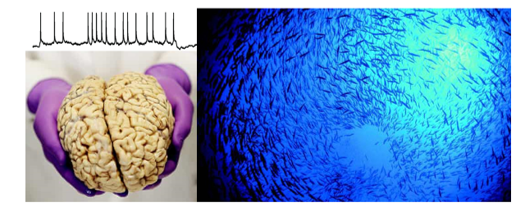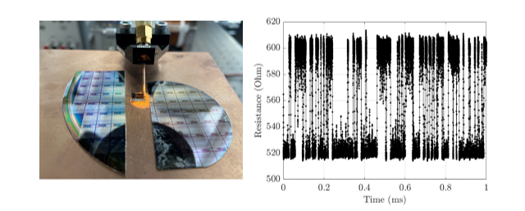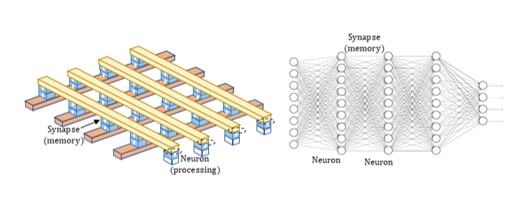Overview
The transversal team aims at bringing together all competencies from SPINTEC involving spintronic devices nanofabrication, characterization, circuit integration, architecture, and algorithm techniques to implement hardware solutions for artificial intelligence (AI) and unconventional computing.
Spintronic-based multifunctional devices are a substantial opportunity to improve the energy efficiency of next-generation computing hardware. Moreover, this approach allows taking advantage of brain-inspired computing models to deploy cutting-edge neuromorphic algorithms, crossing the gap between current hardware AI implementations and exceptional brain computing ability.
Research topics
Bio-inspired computing

As the brain performs very sophisticated operations and consumes only a few Watts, brain-inspired/neuromorphic computing is a promising path for which spintronic devices can efficiently emulate both neurons and synapses in hardware. Their nanometric size, sensitivity to input stimuli, and interactions make those devices ideal for implementing large arrays of neuro-synaptic elements: spintronic nano-oscillators, spintronic and ferroelectric memristors, magnetic memories, superparamagnetic tunnel junctions, skyrmions, etc.
Probabilistic computing

Noise is a crucial ingredient in emulating the stochastic nature of the neural activity and executing energy-efficient computing algorithms such as energy-based or temporal-based machine learning models. In this context, probabilistic computing is a very suitable approach that relaxes usual precision computing constraints. The truly random nature of spintronic devices (such as superparamagnetic tunnel junctions) makes them attractive for hardware implementations of probabilistic computing approaches.
In memory computing

The most promising solutions for non-Von Neumann, in-memory computing architectures are based on the use of emerging technologies, that are able to act as both storage and information processing units thanks to their specific physical properties. High accuracy, Deep neural networks (DNN) can be built with crossbars analog in memory computing concept, involving MRAM families, such as STT, SOT, VCMA, but also with more exotic families of magneto-resistive, and ferroelectric or skyrmion based devices.
The team
Projects
Partners
- CEA LIST
- UMPHY
- CEA LETI
Recent news
- Postdoctoral and R&D positions at SPINTEC to work on unconventional computing and smart communication applications (October 21st, 2025)

Context: In the frame of different French and European collaborative research projects, addressing spintronic innovations for a more frugal, agile and sustainable digital technology, SPINTEC has several postdoctoral and R&D openings for a duration of ... - seminar – Magnetic recording of neural activity using spintronics-based sensors (October 13th, 2025)

On Wednesday, November 12th 2025, we have the pleasure to welcome in SPINTEC Lucas Perez from Universidad Complutense de Madrid and IMDEA Nanociencia. He will give us a seminar at 11:00 entitled : Magnetic recording of ... - seminar – Analog Control of Ferromagnetic Magnetization Through Spin-Orbit Torque for Neuromorphic Computing (September 19th, 2025)

On Wednesday October 01th 2025, we have the pleasure to welcome in SPINTEC Aurélien Lagarrigue from Tohoku University. He will give us a seminar at 14:00 entitled : Analog Control of Ferromagnetic Magnetization Through Spin-Orbit ... - Nanosecond stochastic operation in perpendicular superparamagnetic tunnel junctions (September 08th, 2025)

Superparamagnetic tunnel junctions have emerged as promising stochastic neurons for low-energy cognitive computing. We report, for the first time, nanosecond-scale mean waiting times between magnetization reversals in perpendicularly magnetized tunnel junctions, enabled by a strong ... - PhD Defense – Leveraging Stochastic properties of Spintronic Nanodevices for Unconventional Computing (January 21st, 2025)

On Tuesday 4th of February, at 9:00, Nhat-Tan PHAN (SPINTEC) will defend his PhD thesis entitled : Leveraging Stochastic properties of Spintronic Nanodevices for Unconventional Computing Place : IRIG/SPINTEC, CEA Building 10.05, auditorium 445 (presential access to ...







